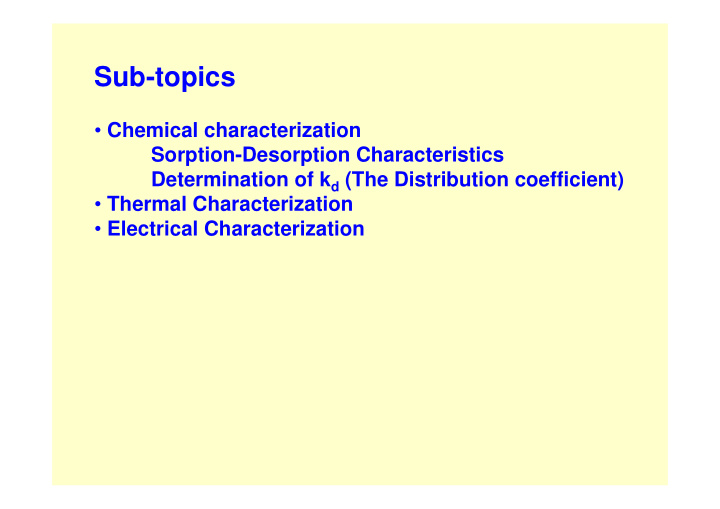



Sub-topics • Chemical characterization Sorption-Desorption Characteristics Determination of k d (The Distribution coefficient) • Thermal Characterization • Electrical Characterization
Sorption Adsorption Absorption Incorporation, Assimilation, Accumulation of substance on surface Inclusion Atoms or molecules move from the bulk phase (that is, solid, atoms or molecules move liquid, or gas) onto a solid or into the bulk of a porous liquid surface. material, e.g. the absorption of water The adhesion of a thin layer of by a sponge molecules of some substance to the surface of a solid or liquid e.g. purification by adsorption where impurities are filtered from liquids or gases by their adsorption onto the surface of a high-surface-area solid such as activated charcoal
Terms related to Sorption • Adsorbates - molecules that have been adsorbed onto solid surfaces • Substrate or Adsorbent - the surface to which adsorbates are adsorbed • e.g. in case of adsorbed cations tightly held on surfaces of negatively charged dry clay particles, clay particle is substrate and cations are adorbates. cations Clay particle
Desorption • a phenomenon whereby a substance is released from or through a surface • process is the opposite of sorption • occurs in a system being in the state of sorption equilibrium between bulk phase (fluid, i.e. gas or liquid solution) and an adsorbing surface (solid or boundary separating two fluids) • When the concentration (or pressure) of substance in the bulk phase is lowered, some of the sorbed substance moves to the bulk state
Simple representation of these processes Water Adsorbed molecule cation Clay layers The cations get fully Dry condition The water molecules hydrated, which results in (cations strongly wedge into the inter-layer their desorption from clay sorbed on clay after adding water surface particles)
SORPTION & DESORPTION CHARACTERISTICS of Geomaterials Excellent philosophy to simulate geomaterial-contaminant interaction Sorption and Desorption are opposite interaction mechanisms Strategies for Remediation of Contaminated Soils/Geomaterials (Site cleanup/Site remediation) Soil washing Soil flushing Vitrification Solidification Immobilization Important to determine Sorption and Desorption Characteristics of Geomaterial and Immobilizing Agents
Importance of Sorption and Desorption Characteristics Fate and Transport of Reactive Contaminant(s) Efficiency of Environmental Cleanup Strategies Selection of Suitable Geological Formations and Backfill Materials Design of Barrier Layers of Waste Containment System Accumulation of Heavy Metals and Pesticides in Subsoil Challenge Precise Determination of these Characteristics (k d & k dl ) in a short duration k d : the coefficient describing sorption process k dl : the coefficient describing desorption process (subscript l corresponds to leaching process)
Recommend
More recommend